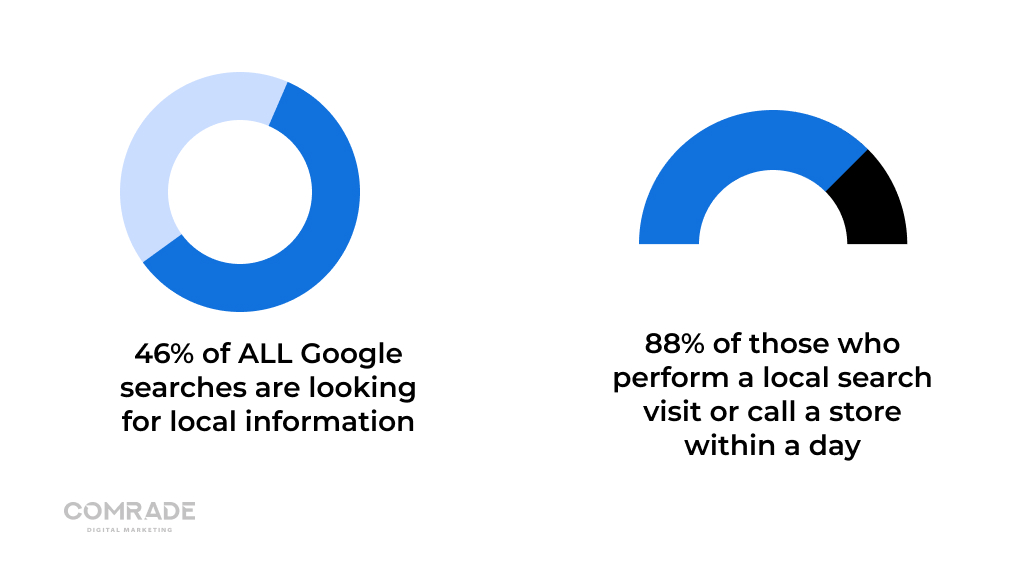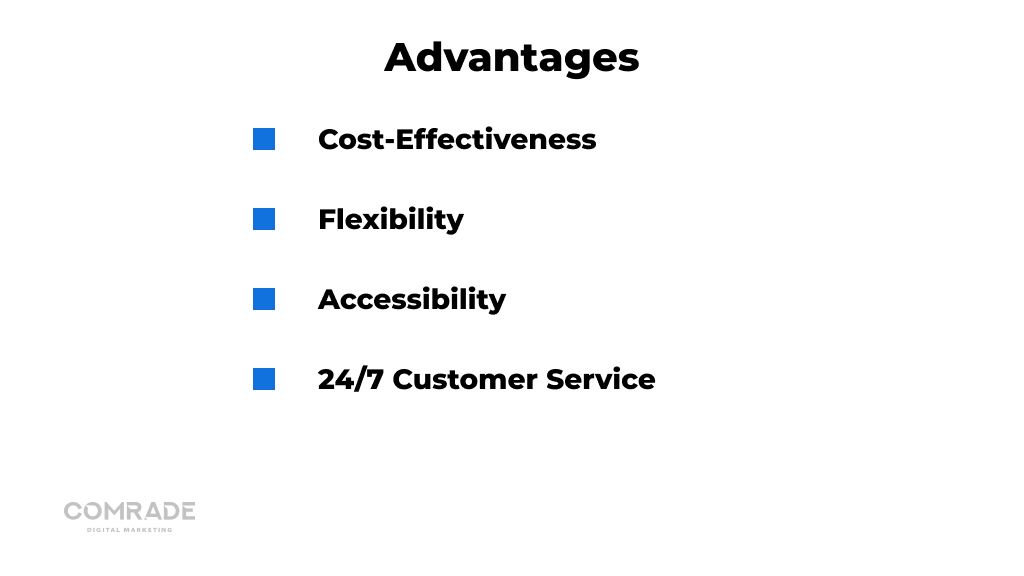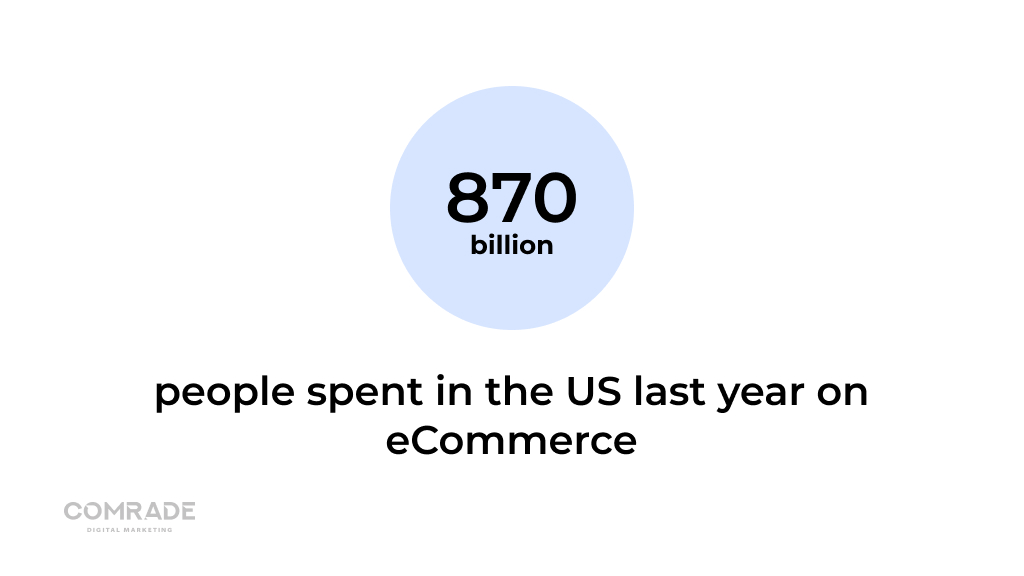The Rise of Ecommerce Businesses
The evolution of digital technology and its subsequent integration into consumers’ everyday lives, as well as the outbreak of Covid-19, has skyrocketed eCommerce sales.
eCommerce allows customers to make purchases online without having to leave the comfort of their homes as long as they have a stable internet connection.
So, are eCommerce business models worth it?
Well, if market projections are anything to go by, according to Beeketing, global eCommerce sales are set to hit $4.9 trillion this year alone. eCommerce businesses can expect to grow by 265%, showing absolutely no signs of slowing down.
As internet accessibility improves across the globe, eCommerce will continue to boom and acquire new customers.
In this blog, we compare traditional retail with eCommerce, to help you choose the best model for your business.
Different Types of Ecommerce

eCommerce business operations are classified according to who is purchasing and who is selling. Clients don’t have to be individual consumers—they can be organizations, businesses and even the government.
Currently, there are six different models:
- Business to Consumer (B2C)
- Business to Business (B2B)
- Business to Government (B2G)
- Business to Business to Consumer (B2B2C)
- Consumer to Consumer (C2C)
- Consumer to Business (C2B)
All entail buying and selling goods or services via the internet and transferring money and data to complete the sales.
Ecommerce and Retail: What’s the Difference?

The basics of eCommerce and retail are very similar: both retail and eCommerce refer to selling products from a business to a consumer. The main difference is that one is done entirely through the internet.
Retail sales can be achieved in multiple ways: in a shopping mall, grocery store, or other brick-and-mortar places; via direct mail or personal sales.
Alternatively, e-commerce is primarily conducted electronically through the Internet. There is also a term “retail e-commerce sales” that refers to sales of goods and services online via an extranet, electronic data interchange (EDI), or similar systems.
An increase in internet accessibility, ease of transaction, product availability, personalized offers, and unlimited physical constraints have made online stores increasingly popular.
Interacting With Products
At brick and mortar stores, customers physically interact with products and become acquainted with the size, feel, and features. Naturally, this makes it easier to determine if they want to buy things.
Conversely, with eCommerce stores, customers rely on product images, videos, and renderings. Although it can be more challenging for customers to make purchases, online retail can improve user experience with 360-degree views, virtual “try-ons”, and sizing comparison charts.
Obtaining Products
If you’re at a physical retail store, with few exceptions (such as clothing showrooms for Bonobos and other eCommerce first companies) when you purchase products, you take them home with you. This provides instant gratification and fulfills the needs of customers who want products immediately.
Even though delivery times have improved (thanks to Amazon), it still takes time for eCommerce products to arrive. However, sometimes consumers are happy to accept longer waiting times for the convenient trade-off of shopping from home.
Consumer Attention Span
It’s impossible for customers to simultaneously be at two physical stores at once. However, with eCommerce, internet users can have multiple “tabs,” and windows open. Often this is to compare products or just part of daily procrastination.
With retail stores, consumers are a captive audience, so to speak, until they physically leave. Yet, with eCommerce, they can “leave” an online store in a split second—they just need to exit the app or close the tab.
This means online retail stores have to work that much harder at captivating customers and leading them down the sales funnel. A great digital marketing plan and a killer website design are the best solutions for customer conversion and retention.
Time to Get Products
Going to a physical store takes time. You have to commute there and back. During the pandemic, consumers had to wait in line before they could enter retail stores. Life is fast-paced, most people aren’t mall rats and would prefer to focus on other things than going to the store.
This is one of the main reasons eCommerce is on the rise. Consumers can open their laptops or pull out their phones, and they’re effectively “in the store.” It doesn’t matter where they are. As long as they have the internet, commute time is nonexistent. Even customer service is taken care of via chatbots.
Operating Hours
With a brick and mortar store, shoppers are restricted to store hours, limiting the sales window. However, an online business can stay open 24/7. Not only can consumers make purchases at whatever times are convenient for them, but they can also buy something at a moment’s notice.
Ecommerce vs. Retail: Differences for Business Owners

Now let’s compare the differences between retail vs. eCommerce for business owners.
Multiple Ad Channels
For retail stores, traditional marketing tactics still hold sway, such as newspaper ads, magazine spreads, billboards, direct mail, radio ads, and TV commercials. On the digital side, locally targeted Google Ads, franchise SEO services and local SEO are extremely effective for targeting and driving potential customers to brick and mortar retail stores.
However, conversions are challenging because ads have to be compelling enough to get customers out of the house. In these cases, tactics like advertising limited products online but only selling them in-store work well.
On the eCommerce side of things, some online retailers do engage in traditional marketing, but the vast majority is conducted via Google Ads, Facebook ads, influencer-sponsored posts, and SEO. Everything is strategically designed to drive clicks since the gap between seeing an advertisement and buying a product is significantly smaller for eCommerce than mortar retail.
Unparalleled Analytics
There are still useful options for physical stores thanks to the latest POS (point of sale) technology. These electronic payment systems provide sophisticated data for physical stores such as the average order amount per customer, the number of products purchased, the most popular products, gross margins, and so on.
Yet, eCommerce stores have the upper hand when it comes to accessing a wide array of analytics, regardless of their sales channels. eCommerce stores have real-time detailed analytics on ad spend, conversions, and overall purchase prices, so much so that marketers can make adjustments and test marketing campaigns in real-time, and then double down on what’s working.
Local Market Impact

Physical retail stores do succeed when it comes to local sales. 46% of ALL Google searches are looking for local information, and 88% of those who perform a local search visit or call a store within a day.
Retail stores that optimize their online presence and business listings to take advantage of local SEO increase their website traffic and Google rankings. Then, of course, there are massive advantages to embracing traditional marketing in local areas too.
That being said, unless a physical store is part of one of those large retail chains like Walmart, or perhaps a franchise, the business is very much relegated to consumers within a specific location.
On the other hand, eCommerce sales extend far beyond a city and can be local, national or even global. Yet, it’s still beneficial for an online store to target specific local areas. For example, an online store selling camping equipment can target its online ad spend to specific geolocations where camping is popular.
Growth Possibilities
A local retail business has a limit to how many customers can be in a store at once, as well as available operating hours. Therefore, sadly, only so many sales can be made in a day. Additionally, there are only so many customers per square mile who you can sell to.
Not so with eCommerce. There is virtually no limitation to online sales. Think of massive retail chains like Shein or Zara. They sell their products to anyone, at any time, in almost any place around the globe!
Startup Capital Required
The initial investment for a brick and mortar store will be high. Leasing a space and interior design require capital. And, of course, you need to stock the store with inventory, and maybe even hire warehouse or storeroom space for stock that can’t go on display. Then there are the running costs, i.e., electricity, utilities, and supplies, not to mention the sales staff salaries.
It’s a different ballgame with eCommerce. If you’re setting up an online store from scratch, of course, you have to find products to sell. But thanks to drop-shipping, you actually don’t even need to have physical products on hand.
You literally just need an eCommerce platform like Shopify, Magento, WooCommerce, BigCommerce or PrestaShop. Once your new store is set up, you then market your products across multiple channels online.
Take note that eCommerce stores, just like physical ones, still require a clear vision, a business plan, and patience, even though they are cheaper to set up. SEO and PPC (online marketing) can become complicated and get expensive quickly if you don’t have the expertise!
Retail Channels
eCommerce businesses typically leverage multiple sales channels to maximize profits. These comprise general marketplaces (Amazon), auction marketplaces (eBay), social media platforms, and eCommerce websites.
Multichannel selling allows businesses to reach customers at multiple touchpoints. Essentially, companies can be wherever their customers are online and keep up with the evolving eCommerce landscape.
To remain competitive and increase sales, online stores are continuously expanding their sale channels based on their specific business and long-term strategies.
Here’s the catch with brick-and-mortar retailing: while you can still utilize traditional retail channels, you’re going to have to invest in digital ones as well.
Opening a Google My Business account and getting your local SEO up to scratch will bring more customers to your store.
Thus, the great thing about being an exclusively online retailer is you only have to focus on digital channels.
The Advantages of Ecommerce

Online shopping is ubiquitous, no longer a luxury but a routine part of life. An eCommerce business can provide scalable opportunities for business owners and customers because it’s cost-effective, flexible and offers 24/7 customer service.
Cost-Effectiveness
The initial capital required for an eCommerce business is less than a traditional retail store. In addition, there are many affordable plug-and-play online platforms with ready-made templates catered for modest and generous budgets like Amazon, Etsy, or eBay, for example.
A single investment in one eCommerce platform can easily reach multiple international markets, and being online offers many cost-effective digital marketing opportunities.
Flexibility
eCommerce doesn’t need a physical storefront. If anything, the only thing you need to worry about is storage space. Furthermore, responsive data gathered from commercial transactions and digital marketing allow you to target different market segments and instantly adapt advertising according to their online habits.
Accessibility
Being online means that consumers can access your products and services at any time, regardless of where they are. One of the advantages of having a store online is that you’re not limited to a physical space and can operate worldwide, with unlimited scalability and opportunity for increased business success.
24/7 Customer Service
eCommerce businesses generally provide excellent customer service due to call center outsourcing or designing custom chatbots that provide constant communication and answer to customer FAQs. Most eCommerce businesses still have customer representatives, but current chatbot technology enables a drastic reduction in customer service staff.
The Disadvantages of Ecommerce

Even though eCommerce is overtaking traditional brick and mortar stores, it is exceptionally competitive, requires intelligent marketing strategies to stand out, and every so often a brand’s reputation can suffer from unforeseeable shipping delays.
Managing Customer Expectations
eCommerce can be deceptive. Many customers have excitedly bought something online only to be disappointed by a poor-quality product that looks nothing like what was advertised.
Even though customers can’t check the quality of what they’re ordering, there’s a lot you can do to build trust in encouraging a purchase. This includes posting online reviews, high-quality photos, and providing measurements of your items, especially in the context of clothing or household items, as well as just selling high-quality goods.
In this sense, it substantially takes more convincing to get customers to buy your products, rather than them walking into a traditional retail store and deciding for themselves.
A Different Set of Sales Skills
With an eCommerce business, you don’t have the opportunity to make face-to-face sales. Understanding and knowing how to do effective digital marketing might require learning an entirely different skill set.
However, there are tonnes of qualified marketing personnel and agencies that can take care of your digital marketing needs and provide ROI without you having to worry about reaching the right market. Working with the appropriate marketing team will help you adapt to future changes and ensure you retain a leading position.
Delayed Shipping
While the possibility of doing international business allows for increased profits, delayed shipping can add to customers’ frustrations, especially if you’re delivering a product to another state or overseas. Having clear T&Cs and tracking order protocols will go a long way in maintaining good customer relations and building a solid business reputation.
The Future of Ecommerce

Issues Traditional Retail Faces
25% of US malls are expected to shut down within the next five years. Long gone are the 1960s heydays of massive suburban malls designed for Americans to gather and form communities.
Traditionally, POS cash registers were designed for the primary purpose of keeping track of which things sold. Today’s multichannel consumer experience involves several touchpoints inside and outside stores.
Smartphones are now the point of sale, making it challenging to keep track of let alone compete across multiple channels at different times when consumers shop. Thus, digital consumption, coupled with eCommerce, has significantly reduced store visits.
Even if retailers dramatically improve conversion rates and invest in multichannel marketing, it will likely not be enough to overhaul online shopping.
Why go to the mall when you can buy the same thing online?
Why You Should Invest in Ecommerce

According to consumer data, in 2021, people spent $870 billion in the US last year on eCommerce. Online sales account for 14.3% of all sales, and while that may not seem like a lot, every year, the percentage continues to grow.
To recap why eCommerce is a sound business choice:
- Online shopping is on the rise.
- It generates profits 24/7.
- There’s limitless scalability.
- Marketing is hyper-targeted.
- It’s generally cheaper than setting up a physical store.
Accelerated by the pandemic and mobile devices, eCommerce has become a normal way of life. Currently, there’s an uptick in voice search. While far from perfect, and not quite adopted by the masses, it stands to experience massive growth.
Over a quarter of the global online population uses voice search on their mobile devices. All tech’s biggest players—Facebook, Google, Amazon and Apple—are investing $750 trillion in spending over the next decade to improve voice recognition.
Beyond that, as competition continues to stiffen, brand differentiation will become more critical to online eCommerce store success. We know strong brands dominate organic acquisition, retain more customers and have the market power to raise prices.
Therefore, investing in short-term performance marketing and long-term brand building is a top priority for eCommerce stores!
Work With Ecommerce Marketing Specialists
Comrade Digital Marketing Agency specializes in web design, Magento development, WooCommerce development services, and SEO services for eCommerce companies. As a full-service digital marketing agency, we can build your store online, as well as grow your business through our world-class digital marketing strategies.
Our team achieves a 65% increase in sales and a 35% increase in conversions on average for our clients. We have over 11 years of experience, which gives every business that works with our high-performance experts a competitive edge. Contact us today to find out how we can get your eCommerce business in front of the right customers.

Frequently Asked Questions
In what cities do you operate?
Comrade originates in Chicago, but we worked all around the United States. We can help your business grow and increase revenue whenever you are. We have offices across most major cities in the US. For example, we can offer digital marketing services in New York or Indianapolis. You can even find our internet marketing experts in San Francisco! If you want to know more about our Houston digital marketing agency or find out how exactly we can help you, contact us via the phone or email.




